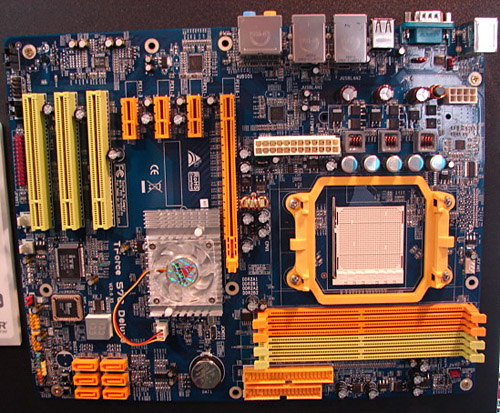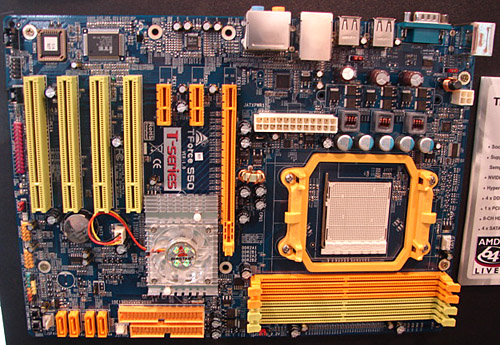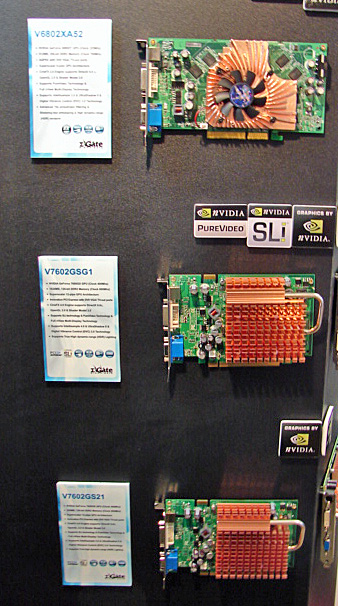Computex 2006: Abit is back, Biostar expands, and Thermaltake dazzles
by Gary Key on June 10, 2006 4:00 AM EST- Posted in
- Trade Shows
Biostar: AMD Motherboards

The TForce 570 U Deluxe board features the NVIDIA nForce 570 Ultra chipset, passive cooling, and Realtek ALC-883 HD audio. Availability is expected within a couple of weeks with pricing not set yet but expected to be in the US $85~$100 range.

Biostar is one of the few manufacturers' offering both the NVIDIA nForce 550 and nForce4 AM2 boards. The main difference between the two is the lack of HD audio and Gb Lan on the nForce4 board. Like the 570 Ultra board, the TForce 550 utilizes active cooling for the MCP chipset. We can expect to see more passive cooling boards from Biostar in their next product release. The TForce 550 is already available and is one of the cheapest AM2 motherboards currently on the market.
Biostar: Video Cards
Biostar has recently introduced a complete line of video cards based upon NVIDIA chipsets ranging from the 7950 GX2 to the FX5200.

The above shot shows three of the more interesting video cards in the Biostar booth: the V6802XA52, V7602GSG1, and V7602GS21. The V6802XA52 features the 6800XT chipset on an AGP 8x bus with 512MB of DDR2 memory running at 700MHz with a core clock speed of 325MHz. While obviously outdated for today's latest systems, Biostar believes it to be a better upgrade path than other AGP based cards for those still running AGP based systems. Considering the amount of Intel 865 based boards we viewed with full support for Conroe this might not be a bad choice for those on a very limited budget. The V7602GSG1 is based on the 7600GS chipset but has 1024MB of memory running at 800MHz with a core speed of 400MHz and is passively cooled. This was the first 7600GS card we noticed with 1024MB of memory. Whether the card can utilize this amount of memory properly is debatable but it was nice to see cards including 1024MB at mainstream pricing. The V7602GS21 goes for a more common 256MB of video memory, for those that don't believe in overkill.

The TForce 570 U Deluxe board features the NVIDIA nForce 570 Ultra chipset, passive cooling, and Realtek ALC-883 HD audio. Availability is expected within a couple of weeks with pricing not set yet but expected to be in the US $85~$100 range.

Biostar is one of the few manufacturers' offering both the NVIDIA nForce 550 and nForce4 AM2 boards. The main difference between the two is the lack of HD audio and Gb Lan on the nForce4 board. Like the 570 Ultra board, the TForce 550 utilizes active cooling for the MCP chipset. We can expect to see more passive cooling boards from Biostar in their next product release. The TForce 550 is already available and is one of the cheapest AM2 motherboards currently on the market.
Biostar: Video Cards
Biostar has recently introduced a complete line of video cards based upon NVIDIA chipsets ranging from the 7950 GX2 to the FX5200.

The above shot shows three of the more interesting video cards in the Biostar booth: the V6802XA52, V7602GSG1, and V7602GS21. The V6802XA52 features the 6800XT chipset on an AGP 8x bus with 512MB of DDR2 memory running at 700MHz with a core clock speed of 325MHz. While obviously outdated for today's latest systems, Biostar believes it to be a better upgrade path than other AGP based cards for those still running AGP based systems. Considering the amount of Intel 865 based boards we viewed with full support for Conroe this might not be a bad choice for those on a very limited budget. The V7602GSG1 is based on the 7600GS chipset but has 1024MB of memory running at 800MHz with a core speed of 400MHz and is passively cooled. This was the first 7600GS card we noticed with 1024MB of memory. Whether the card can utilize this amount of memory properly is debatable but it was nice to see cards including 1024MB at mainstream pricing. The V7602GS21 goes for a more common 256MB of video memory, for those that don't believe in overkill.










27 Comments
View All Comments
Operandi - Sunday, June 11, 2006 - link
Lian Li and SilverStone need companies like Thermaltake to make ugly ass cases to make theirs look good. ;)Griswold - Saturday, June 10, 2006 - link
Or the all-time classic:Optimus Prime called, he wants his chest armor back!
Lonyo - Saturday, June 10, 2006 - link
Putting passive cooling on their "max" motherboard. It makes me sad.vailr - Saturday, June 10, 2006 - link
Only one PCI slot on Abit's "Top of the Line" board? No thanks. Would need at least 2, or preferably 3 PCI slots.And regarding the passive/heatpipe chipset cooling: these won't work with some of
the Lian-Li mid-tower cases where the motherboard is oriented "upside-down".
Chernobyl68 - Saturday, June 10, 2006 - link
That was my first thought when I started seeing all of the passive cooling solutions out there...how would it work with the Lian-Li case I plan to buy? do I need to reconsider my options? I thought all I was waiting on was an acceptable motherboard to be released before I make my new system but I may be waiting a bit longer.Chern
Gary Key - Saturday, June 10, 2006 - link
We discussed this at length with Abit, too late to change now but we told them there would be a backlash. Also, if you run CrossFire or SLI, that single PCI slot is gone.
LoneWolf15 - Saturday, June 10, 2006 - link
Major case of "Aim gun at foot, pull trigger".
Unless Abit is willing to come up with some high quality PCIe peripherals to match, their high-end single-PCI slot boards are worthless, and releasing them will be a major monetary loss. With Crossfire/SLI, this means no Creative X-Fi (or insert other better-than-onboard-sound-card here), and limited choice of any other peripherals.
Universally stupid.
JarredWalton - Saturday, June 10, 2006 - link
The only major loss is sound card support, as you can currently get Theater 550 TV Tuners in PCIe format. I'm personally finding onboard audio sufficient for my needs, especially with the latest HDA solutions. X-Fi sounds better and cleaner, but it's not something you really notice unless you have really nice speakers/headphones.It's sort of like integrated NICs - is there anyone out there that really cares about the difference between 700 Mbit vs. 950 Mbit GbE performance? The only time I touch those speeds is when doing theoretical tests; HDD speeds are the limit otherwise, and gaming? Don't make me laugh: games don't even stress a 10 Mbit Ethernet connection in most instances, and certainly don't need more than 100 Mbit.
Anyway, my point is that integrated audio is fast nearing the point where few people worry about add-in sound cards. Get some digital speakers and use the S/PDIF connections on nice motherboards, and I'd love to see some people do a "blind" listening test. I'm sort of curious about what percentage of our readers still use add-in sound cards - I would be surprised if it's more than 10%.
Odeen - Tuesday, June 13, 2006 - link
There are a few problems with onboard audio. The sound quality is one of them. The second problem is the PERFORMANCE hit and the 3d sound rendering features available.Basically, onboard audio (and outboard audio processors without hardware DS3D and EAX support can emulate EAX, but not perfectly. EAX 4.0 is a no-go at all. And this emulation is tantamount to doing software 3D rendering - it's very slow, especially when dozens of sounds need to be located in 3D space and processed.
Any gamer owes it to himself to use a sound card capable of 3D sound processing, or they're cheating themselves out of frame rates.
BPB - Saturday, June 10, 2006 - link
Did they really think that people running Crossfire setups wouldn't at least want better-than-onboard sound? That alone is one PCI slot. The onboard sound looks good, but is it that good?